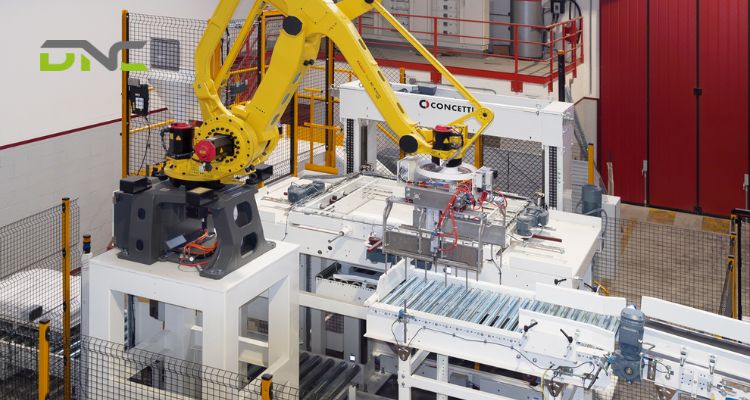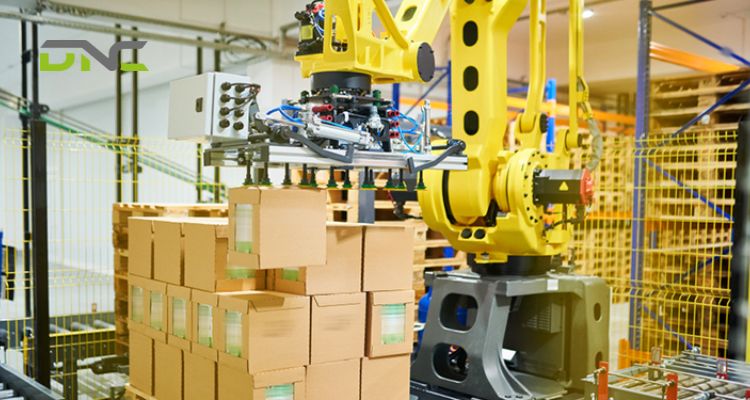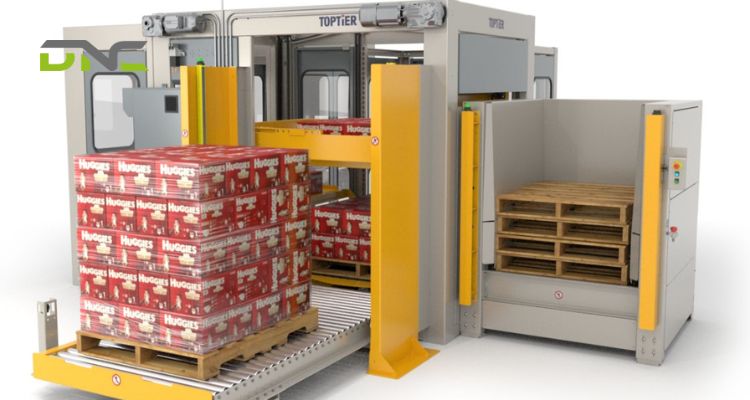Automated Palletizer: Boosting Efficiency and Safety in Manufacturing
An automated palletizer is a machine designed to stack goods onto pallets in a structured pattern for easier handling, storage, and shipment. Instead of relying on manual labor, these systems use robotic or mechanical technology to automate the palletizing process — ensuring faster and more consistent results.
What Are the Benefits of Automated Palletizers for Industries?
For Malaysian manufacturers, the move toward automation is driven by the need for efficiency, safety, and cost control – all of which automated palletizers deliver.
- Increased Throughput and Consistency: Automated palletizers can handle thousands of units per hour with consistent stacking precision. This results in shorter cycle times, increased productivity, and enhanced quality control across production lines.
- Enhanced Workplace Safety: Manual palletizing exposes workers to repetitive lifting and injury risks. Automation eliminates these hazards by performing the heavy lifting, improving ergonomics and safety standards in industrial environments.
- Lower Operational Costs: By reducing manual labor, optimizing floor space, and enhancing energy efficiency, automated palletizers provide a strong return on investment (ROI). Malaysian manufacturers can expect long-term cost optimization and higher production efficiency.
- Improved Supply Chain Reliability: Automated palletizers ensure consistent packaging quality and stacking accuracy, minimizing product damage during transport. This enhances supply chain reliability and strengthens relationships with distributors and customers.
- Scalability and Flexibility: Modern palletizing systems can easily adapt to different product types, packaging materials, and pallet configurations. This flexibility allows Malaysian manufacturers to respond quickly to market demands and production changes without significant downtime.

What Are the Benefits of Automated Palletizers for Industries?
Key Components and Technologies Behind Automated Palletizers
Modern automated palletizers combine advanced mechanical and digital technologies to achieve fast, precise, and reliable stacking performance. Each component works together to ensure smooth handling and seamless automation.
- Conveyors: Move products efficiently through different stages, ensuring steady flow and proper alignment before stacking.
- Grippers and End Effectors: Handle various product shapes and weights with precision, preventing damage while maintaining stability.
- Vision Systems: Use cameras and sensors to guide robotic movements, enabling accurate placement and error detection.
- PLCs and Sensors: Act as the control hub, monitoring system performance in real time and adjusting operations for maximum speed, safety, and efficiency.
What Types of Palletizers Are Commonly Used in Malaysia?
Manufacturing landscape uses a variety of palletizing solutions tailored to industry needs and production volumes.
- Robotic Palletizers: Favored for flexible automation and compact layouts, robotic palletizers are increasingly popular in industries with frequent product changes or limited floor space.
- High-Level and Low-Level Palletizers: These conventional models are ideal for large-scale production in food and beverage or FMCG sectors — offering speed, reliability, and easy integration with existing packaging lines.
- Collaborative (Cobot) Palletizers: Designed for SMEs and facilities prioritizing safety, cobot palletizers work alongside human operators without fencing — combining ease of use with space-saving design.
What Are the Main Industry Applications of Automated Palletizers?
Automated palletizers are transforming operations across multiple industries in Malaysia, including FMCG, food & beverage, logistics, pharmaceuticals, and e-commerce.
- Food and Beverage Manufacturing: Palletizers help ensure hygiene, precision, and consistency when stacking packaged goods, crucial for maintaining food safety standards and meeting high-volume demands.
- Logistics and Warehousing: In logistics centers, palletizers automate dispatch, sorting, and inventory handling to support faster deliveries and streamlined warehouse operations.
- Pharmaceuticals and Consumer Goods: The pharmaceutical sector requires traceability and compliance with GMP standards. Automated palletizers equipped with barcode tracking ensure full visibility throughout the packaging process.
- Chemical and Industrial Manufacturing
In chemical and industrial plants, palletizers handle heavy or hazardous materials safely and precisely, reducing manual handling risks while maintaining packaging integrity.

What Are the Main Industry Applications of Automated Palletizers?
Where to Find the Right Automated Palletizer?
To ensure maximum performance, reliability, and return on investment, partnering with an experienced automation integrator is essential. A trusted partner provides not just equipment but complete system integration from design, installation, and programming to ongoing maintenance. This holistic approach minimizes downtime, ensures seamless communication between machines, and guarantees that your palletizing system operates efficiently within your existing production line.
DNC Automation stands out as one of Malaysia’s leading automation solution providers. With extensive industry experience, DNC delivers customized, end-to-end palletizing solutions that align with each client’s operational goals. Their commitment to innovation, quality engineering, and responsive after-sales support makes them a reliable partner for manufacturers seeking long-term automation success.
- 0 views
- 0 Comment




Recent Comments